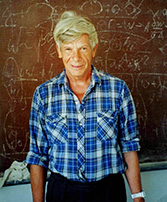Speaker
Description
We consider the massless and massive theory of higher spin (HS) fields within the BRST approach and construct a (off-shell) general cubic interaction vertices corresponding to the irreducible HS fields on the d-dimensional flat spacetime. To this end, we develop a concept of deformation Noether's procedure of free gauge theory on a base of BRST approach with complete BRST operator.
As compared to previous works on cubic vertices, which did not take into account sequentially traceless constraints, we use the complete BRST operator,
\begin{eqnarray}
Q =
\eta_0l_0+\eta_1^+l_1+l_1^{+}\eta_1+
\eta_{11}^+\widehat{L}{11}+\widehat{L}{11}^{+}\eta_{11} +
{\imath}\eta_1^+\eta_1{\cal{}P}_0
,\end{eqnarray}
which includes trace constraints $\widehat{L}_{11}$ (and its dual) $\widehat{L}_{11}^{+}$ necessary to describe together with differential constraints (d;Alambert $l_0$, divergence $l_1 $ and its dual $l_1^{+}$) irreducible representations of Poincare group with integer spins $s$. $Q$
(used here to find gauge-invariant Lagrangian formulation for initial non-Lagrangian equations) depends,on the Grassmann-odd ghost operators $\eta_0, \eta_1^+,\eta_1,
\eta_{11}^+,\eta_{11}$, ${\cal P}_0$, ${\cal P}_{1}$, ${\cal P}^+_{1},$ ${\cal P}_{11},{\cal P}^+_{11}$.
As a result, we covariantize the cubic vertices given as three-vectors in oscillator representation $\big| V^{(3)}\rangle^{(m)_3}_{(s)_{3}}$, firstly found in light-cone formalism [R.Metsaev, Nucl. Phys.B 759 (2006) 147] with preserving the irreducibility for the fields on the interacting level with the same (as for dynamics of free fields) numbers of physical degrees of freedom for each copy of interacting higher spin fields incorporated into field vectors from the respective Fock space. The operator of cubic vertex satisfies to the properties of BRST and spin closeness
\begin{equation}
\sum_i Q^{(i)}
\big|{V}{}^{(3)}\rangle^{(m)3}{(s)3} =0, \qquad
\sigma^{(i)}\big|{V}{}^{(3)}\rangle^{(m)_3}{(s)_3} \ =\ 0,
\end{equation}
(for $i=1,2,3$ enumerating the copy of fields, masses $(m)_3=(m_1,m_2,m_3)$ and spins $(s)_3=(s_1,s_2,s_3)$).
As compared to the covariant form of the vertices obtained with using BRST approach with incomplete BRST operator [R.Metsaev,Phys. Lett. B 720 (2013)
237], the interacting theory with complete BRST operator leads to new contributions to the vertex that contain additional terms with fewer space-time derivatives of fields, as well as with multiple trace contributions.
We found the general solution for the equations above, for interacting, first, massless higher spin fields, with helicities $(s_1,s_2,s_3)$ in [I.L. Buchbinder, A. Reshetnyak, Phys. Lett. B 820 (2021) 136470], second, one massive with mass and spin $(m,s_1)$ and two massless fields
with $(0,s_2)$, $(0,s_3)$, third, two massive and one massless higher spin fields both for general case of different masses and for critical case of coinciding masses.

